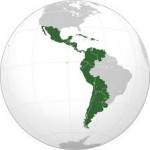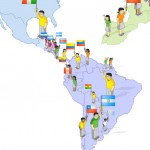 Over the last twenty years, Spanish companies have made huge investments abroad, transforming the image of Spain from country which relies on tourism for its income to a serious player in the global economy. Walk through any major city centre and you’ll find a Spanish retailer: Zara, Mango, Pull & Bear. In the financial sectors, Spanish banking giant Santander is ranked as one of the best 5 banks in the world, and telecommunications company Telefónica is one of the most powerful companies of its kind in the world, and undisputed leader in Latin America.
Over the last twenty years, Spanish companies have made huge investments abroad, transforming the image of Spain from country which relies on tourism for its income to a serious player in the global economy. Walk through any major city centre and you’ll find a Spanish retailer: Zara, Mango, Pull & Bear. In the financial sectors, Spanish banking giant Santander is ranked as one of the best 5 banks in the world, and telecommunications company Telefónica is one of the most powerful companies of its kind in the world, and undisputed leader in Latin America.
These are just a few examples and it’s a success story that is being repeated the world over. In fact, data from the Organisation for Economic Co-operation and Development (OECD) places large Spanish firms among the most lucrative on the international stage, some way above Germany and Great Britain.
Being able to speak a second language is an undeniable asset in today’s globalised world. The rapid expansion of Spanish companies in the global market place, as well as the number of Spanish-speaking emerging economies which we examined in a previous blog, surely places Spanish at the top of the most desirable and useful languages one could choose to learn. If you would like to join the growing number of Spanish speakers in the world, choose from private Spanish lessons, group training or intensive Spanish courses available with our patient and experienced native tutors throughout the Greater London area.

 This year’s GCSE results showed a marked and very welcome increase in the take-up of modern foreign languages amongst school pupils. It’s the first time in over a decade that the number of students studying a language to this level has risen. Though French and German both registered an increase, at 15.5 per cent and 9.4 per cent respectively, and some other minority languages enjoyed something of a surge, Spanish outstripped all other languages with a huge rise of 25.8 per cent. It remains to be seen whether these same students will go on to complete A-levels in their chosen languages. For the moment though, the downward trend at that level continues with numbers of French and German students still in decline. Only Spanish is on the rise with an increase of 4.1 per cent at A-level this year.
This year’s GCSE results showed a marked and very welcome increase in the take-up of modern foreign languages amongst school pupils. It’s the first time in over a decade that the number of students studying a language to this level has risen. Though French and German both registered an increase, at 15.5 per cent and 9.4 per cent respectively, and some other minority languages enjoyed something of a surge, Spanish outstripped all other languages with a huge rise of 25.8 per cent. It remains to be seen whether these same students will go on to complete A-levels in their chosen languages. For the moment though, the downward trend at that level continues with numbers of French and German students still in decline. Only Spanish is on the rise with an increase of 4.1 per cent at A-level this year. In a previous blog we looked at the indisputable importance of Spanish in the world. It’s relevance as a language becomes even greater, however, when we consider how many of the emerging economies are Spanish-speaking countries.
In a previous blog we looked at the indisputable importance of Spanish in the world. It’s relevance as a language becomes even greater, however, when we consider how many of the emerging economies are Spanish-speaking countries. The Royal Spanish Academy is the official royal body responsible for regulating the Spanish language. It is usually abbreviated to RAE, an acronym for its Spanish title, Real Academia Española. The academy was founded in 1713 and is based in Madrid, but it also plays a role in governing the language spoken in twenty-one other countries through its affiliation with the Association of Spanish Language Academies (Asociación de Academias de la Lengua Española), set up in Mexico in 1951 which is a union of all the separate language academies in the Spanish-speaking world.
The Royal Spanish Academy is the official royal body responsible for regulating the Spanish language. It is usually abbreviated to RAE, an acronym for its Spanish title, Real Academia Española. The academy was founded in 1713 and is based in Madrid, but it also plays a role in governing the language spoken in twenty-one other countries through its affiliation with the Association of Spanish Language Academies (Asociación de Academias de la Lengua Española), set up in Mexico in 1951 which is a union of all the separate language academies in the Spanish-speaking world. Studies of languages used on the internet* show, unsurprisingly, that English is the most-used language online, with around 55% of websites using English as their content language. Spanish is among the group of next most highly-used languages along with German and Russian. What is significant though is that use of the Spanish language online increased dramatically in the ten years between 2001 and 2011, expanding at a rate of 743%, compared to 281% for English. This can perhaps be seen as confirmation of the growing importance of Spanish as a world language and the rapid expansion in the numbers of Spanish speakers in recent years, particularly in the US.
Studies of languages used on the internet* show, unsurprisingly, that English is the most-used language online, with around 55% of websites using English as their content language. Spanish is among the group of next most highly-used languages along with German and Russian. What is significant though is that use of the Spanish language online increased dramatically in the ten years between 2001 and 2011, expanding at a rate of 743%, compared to 281% for English. This can perhaps be seen as confirmation of the growing importance of Spanish as a world language and the rapid expansion in the numbers of Spanish speakers in recent years, particularly in the US. The presence of Spanish influence and the Spanish language in the Americas goes all the way back to Christopher Columbus’ arrival there in 1492. Over the next four centuries the Spanish Empire expanded across Mexico, most of Central America, the western half of South America and the Caribbean. Its reach even extended to the northern states of Washington and Oregon. Spanish rule in many areas of the Americas endured right up until the revolutionary movements of the nineteenth century, at which point the colonies were lost, but the language remained.
The presence of Spanish influence and the Spanish language in the Americas goes all the way back to Christopher Columbus’ arrival there in 1492. Over the next four centuries the Spanish Empire expanded across Mexico, most of Central America, the western half of South America and the Caribbean. Its reach even extended to the northern states of Washington and Oregon. Spanish rule in many areas of the Americas endured right up until the revolutionary movements of the nineteenth century, at which point the colonies were lost, but the language remained. According to the US Census Bureau, the number of Spanish speakers in the US has more than doubled since 1990 and the number of people aged five and older who now speak Spanish at home as their first language now totals almost 37 million. When we take into account the number of people who speak Spanish as a second language, the total rises to 45 million, and a further 6 million are said to be learning Spanish in the US today. Given this staggering rate of growth, it’s thought that by the year 2050 the number of Spanish speakers in the US could rise to as many as 100 million.
According to the US Census Bureau, the number of Spanish speakers in the US has more than doubled since 1990 and the number of people aged five and older who now speak Spanish at home as their first language now totals almost 37 million. When we take into account the number of people who speak Spanish as a second language, the total rises to 45 million, and a further 6 million are said to be learning Spanish in the US today. Given this staggering rate of growth, it’s thought that by the year 2050 the number of Spanish speakers in the US could rise to as many as 100 million.
 I’m often asked about the benefits of learning Spanish, and I frequently tell my students that one of the greatest benefits is being able to communicate when you visit a Spanish-speaking country.
I’m often asked about the benefits of learning Spanish, and I frequently tell my students that one of the greatest benefits is being able to communicate when you visit a Spanish-speaking country.